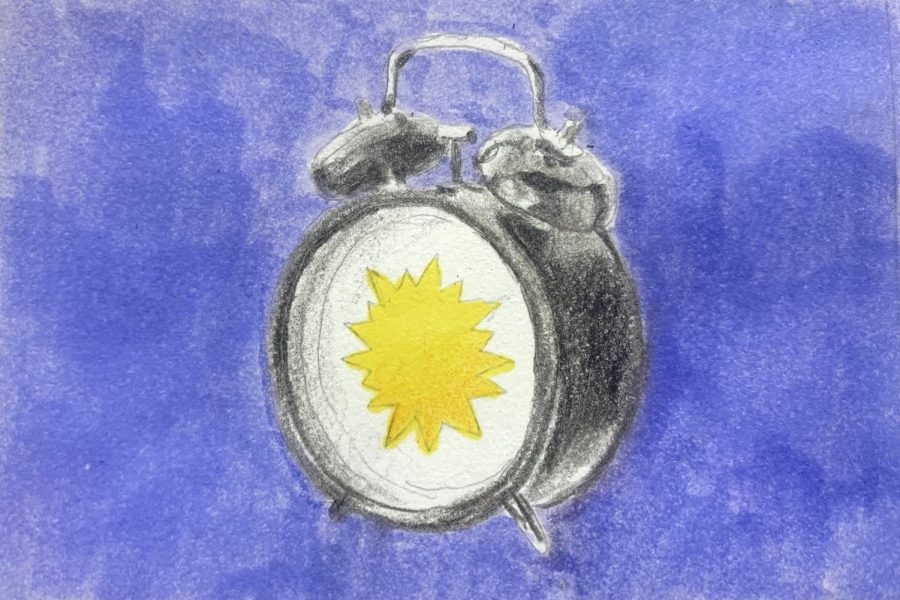Opinion: Time to stop changing
Credit: Alyssa Ao
WSPN’s Talia Macchi discusses her thoughts on Daylight Savings Time and the harms that standard time causes.
November 29, 2022
Twice a year, on the second Sunday in March and on the first Sunday in November, I hear the words, “don’t forget to change your clock,” come out of my mother’s mouth. These words have, unfortunately, become a bi-annual ritual for me.
When I was younger, I saw the whole world change their clocks an hour back in the fall to standard time for no good reason at all, it seemed. The beneficial aspects of daylight savings time (DST) were reversed each time my mother set back the clocks that first Sunday in November.
As I grew older, questions about this change emerged. Why do we do this? Who came up with this? I learned that time change was first implemented in North America as a measure to conserve energy and better utilize daylight during World War I.
Now, as a junior in high school, I ask why has this nonsensical law stuck, and why hasn’t Mr. President held a vote to pass the Sunshine Protection Act of 2021?. This act abolishes clock changes, creating a permanent daylight savings time. This would mean forever remaining in the ‘spring forward’ zone of DST, with fresh dawning mornings and energizing days, along with gorgeous sunsets. Days like these should be permanent, clock changes should be abolished and The Sunshine Protection Act should be passed.
When we turn DST off every fall and return our clocks to standard time, the sunrise and sunset are earlier in the day, making for a continuous cycle of blinding mornings, gloomy afternoons and sleepless nights. As a result of the lack of sunlight during the four long standard time months, our melatonin and serotonin levels rise, leading to apathy feelings and seasonal depression.
As a student-athlete, I feel unmotivated and burnt out during this time of year. I force my lifeless body out of bed as the sun creeps in, and cram my tired head with trivial knowledge and dance choreography during the day.
By the time I come back to my abode, it’s already dark out again, and my brain is begging me to go to bed. I have to fight with my zombie-like body to complete my several hours of homework, while still finding time to exercise and feed myself. I feel completely drained. It’s very difficult to battle your programmed brain with your physically exhausted body, especially at the delicate age of 16.
Even politicians don’t like the idea of changing the clocks. Florida senator, Marco Rubio, argues that Americans should not have to suffer through the inconveniences that come with changing the clocks, and that sunnier afternoons will make people happier and healthier. I agree. The sooner the Sunshine Protection Act is passed, the sooner people of the U.S. will thrive, making for years of prosperity and joy.
Standard time brings darkness to the day, and darkness is dangerous. More car crashes happen during the nighttime due to crowded roads and weary-eyed drivers. As a new driver, I feel more alert and comfortable while the sun is shining above me. Just last week, I was driving on the highway and saw a sign that read, “Stay awake, arrive alive,” which worsened my driving anxiety at that moment. Longer nights, due to standard time, would put drivers at risk. With DST, driving is more safe.
The time change has also brought an uptick in suicides. Further, more robberies and crimes occur during the darkness. The sunshine that a perpetual DST would bring would eliminate these deadly consequences of standard time, making citizens of the U.S. safer.
DST is accepted as a way to save energy and daylight during the warmer months. More sunlight requires less electricity consumption, and reduces the amount of energy and heat used to warm buildings. This would ultimately decrease the amount of oil and heat being used throughout the year. If the U.S. had ordained a permanent DST more than a decade ago, we would’ve seen energy savings of more than $4 billion, and a decrease in carbon emissions by 10.8 million metric tons.
Climate change is a very large and important issue in the world right now and carbon emissions are the leading force that powers the earth’s warming. If DST will save energy and decrease carbon emissions, then the whole world should be in favor, because the planet is dying.
Another plus of DST is the strengthening effect it has on the economy. Do you know what a better economy leads to? It leads to higher average incomes, allowing more people to enjoy better living standards. It’s proven that more people go out and spend money during the light hours of the day. I know I do.
The Chamber of Commerce tends to support DST because of its positive effect on the economy. If DST supports the growing economy, while also subsiding global warming, then the Sunshine Protection Act is a no-brainer. The sooner the act is passed, the sooner energy is saved and money is made, making for an improved environment and economy.
Year after year, the desire amongst most Americans to permanently change to DST becomes stronger, and the Sunshine Protection Act is only gaining more traction. Nearly 20 states have passed laws to make DST permanent. Now, we are just waiting for the federal go-ahead to make this extremely beneficial act a reality.
The justification for changing the clocks is antiquated, and makes many Americans frustrated, including my young self. The sun setting at four p.m. is the tell-tale sign of winter, bringing more anxiety, despair and sleeplessness to many Americans. It causes more annoyance than good.
I hope that someday this under-appreciated practice of DST is no longer a thing of debate, and that standard time is something of the past for my generation. At least for now, I can look forward to the short, but sweet, four months of DST. With all the other unstable changes occurring in our country these days, the Sunshine Protection Act should be easily approved because the arguments are so visible. It’s past time to put changing time in the past.





![Last Wednesday, the Wayland School Committee gathered to discuss a number of topics regarding the health curriculum and Innovation Career Pathway course. Another large topic of conversation was the ways to potentially mitigate distracting cell phone usage. "These [phones] are going to distract your learning and social relationships," Superintendent David Fleishman said. "That's concrete right there."](https://waylandstudentpress.com/wp-content/uploads/2025/06/Screenshot-2025-06-04-at-9.49.31 PM-1200x886.png)



























![Troy Hoyt finishes the Boston Marathon, running for the Hoyt Foundation. T. Hoyt is the son of Hoyt Foundation CEO Russ Hoyt.
“[Running a marathon] might seem like a big thing, when it’s presented to you at first, but if you break it up and just keep telling yourself, “Yes, you can,” you can start chipping away at it. And before you know it, you’ll be running the whole 26 miles, and you won’t even think twice about it.” T. Hoyt said.](https://waylandstudentpress.com/wp-content/uploads/2025/04/C36E8761-1CBB-452E-9DF2-543EF7B1095E_1_105_c.jpeg)














































